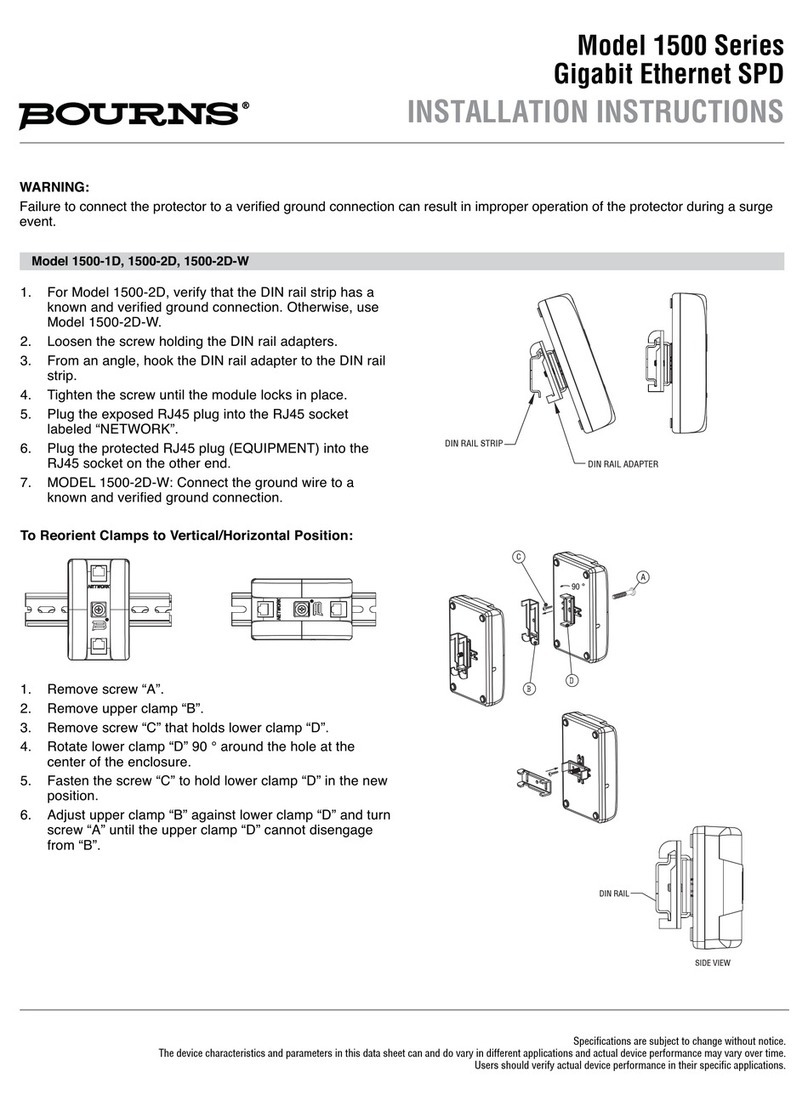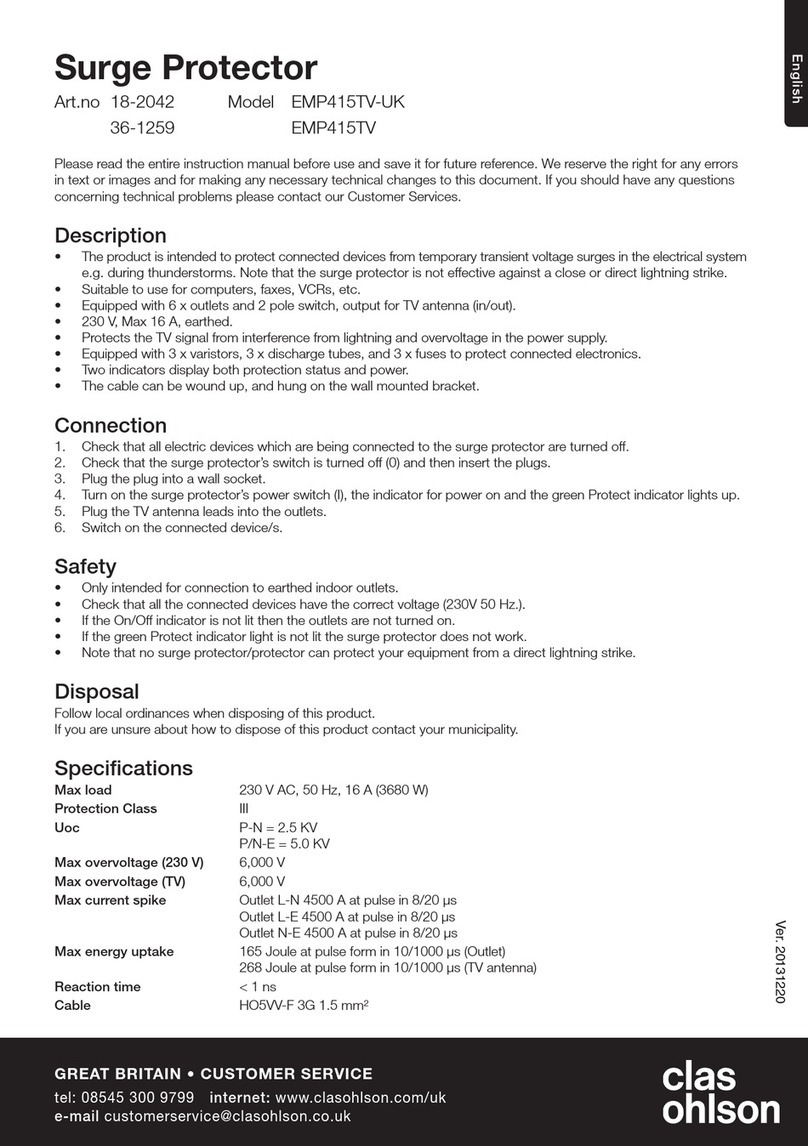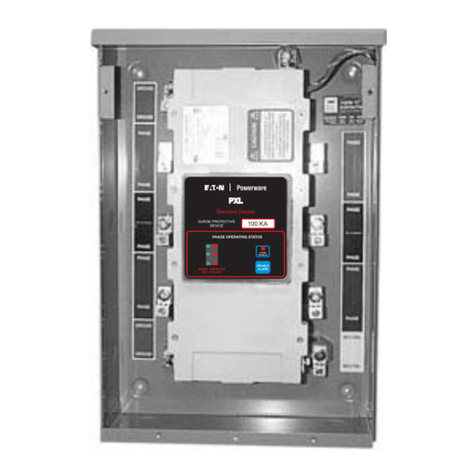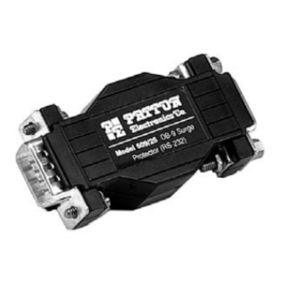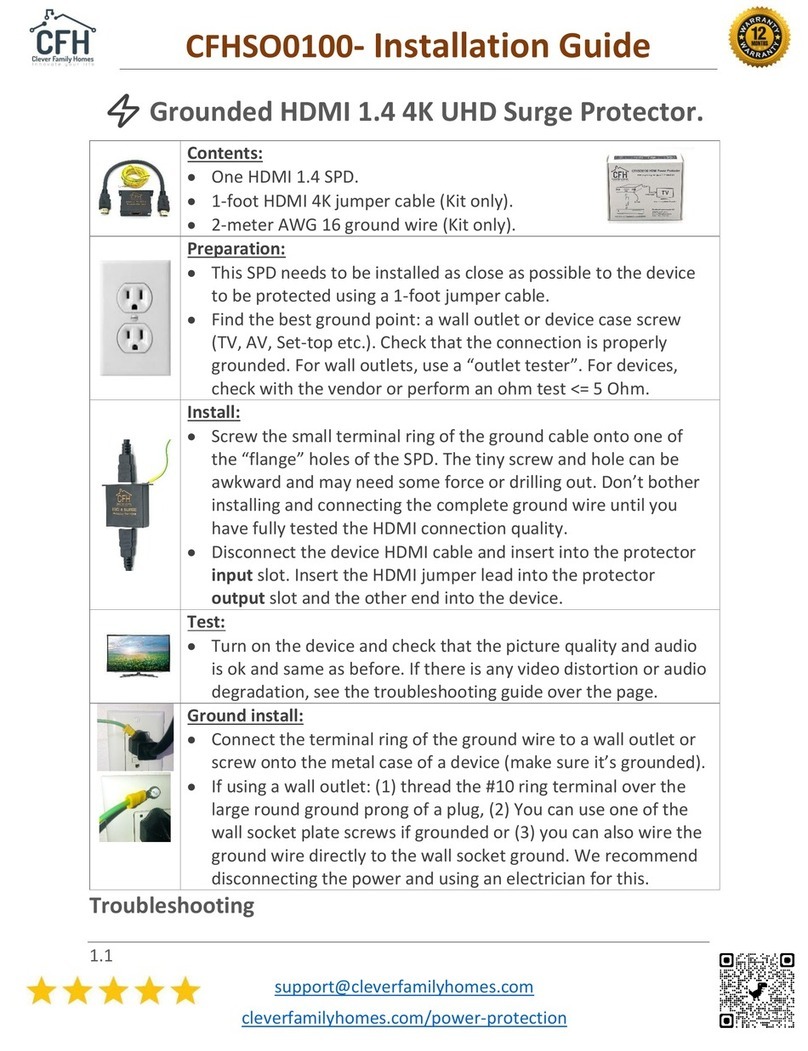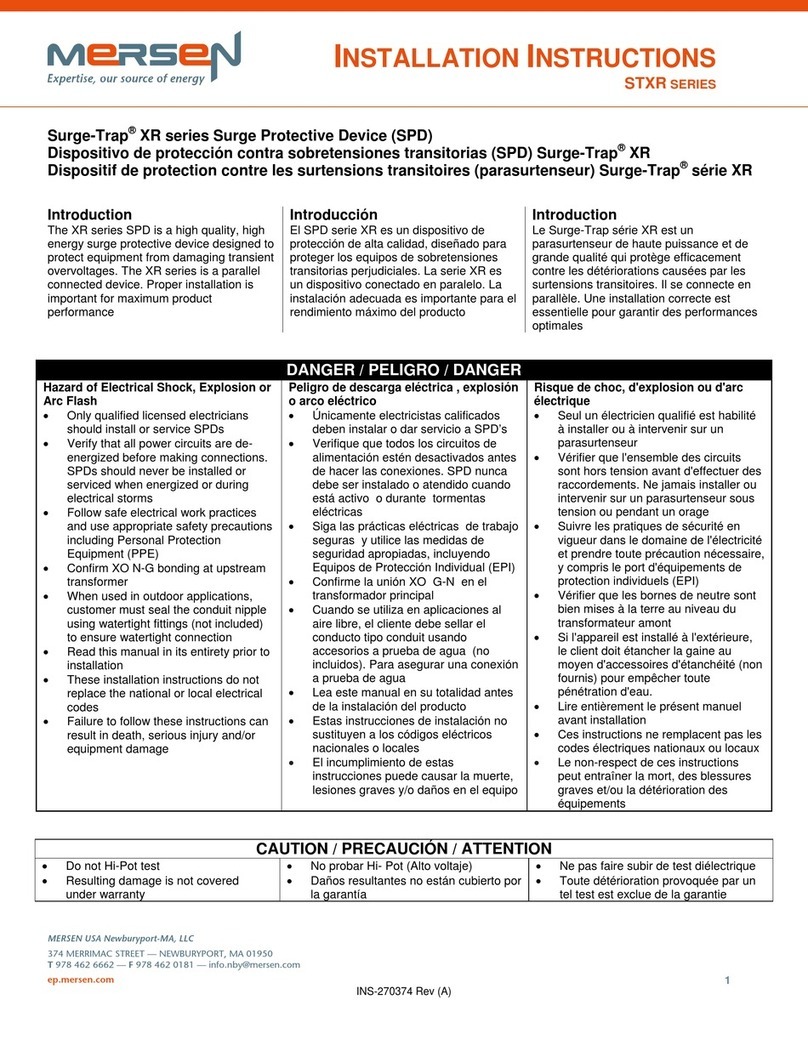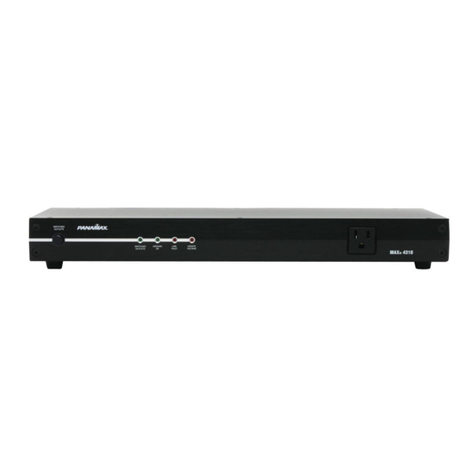Bourns 4030 User manual

Bourns®Model 4030
Surge Protector Test Set
USER
MANUAL

Bourns®Model 4030 Surge Protector Test Set
ii
DANGER! HIGH VOLTAGE
WARNING
DO NOT CONNECT TO ENERGIZED EQUIPMENT
SURGE PROTECTOR
TEST SET
M
ODEL 4030-01
PEAK VOLTAGE
Series Resistance in Ohms
(OPEN is > 150 Ohms)
Measurement only available
through the 5-pin socket
L1-C
+
L1-C
-
L1-C
+
L1-C
-
L1-L2
-
L1-L2
+
TIP RING
L1 C
T
I
P
R
I
N
G
L2

iii
USER MANUAL
DANGER! HIGH VOLTAGE
WARNING
DO NOT CONNECT TO ENERGIZED EQUIPMENT
SURGE PROTECTOR TEST SE
T
MODEL 4030-01
PEAK VOLTAGE
Series Resistance in Ohms
(OPEN is > 150 Ohms)
Measurement only available
through the 5-pin socket
L1-C
+
L1-C
-
L1-C
+
L1-C
-
L1-L2
-
L1-L2
+
TIP RING
L1 C
T
I
P
R
I
N
G
L2
Safety
Description
eory of Operation
Testing of AC Surge Protectors
Calibration
Specications
Battery Testing, Installation and Replacement
AC Power Option
Removal of 9 V Battery
Installation of 9 V Battery
Battery Disposal
Ramp (dv/dt) Setting
Testing DCBD (DC Breakdown)
Tester Conguration Options
Removal from the DIN Rail
Ordering Information
Test Accessories
4030 Surge Protector Test Set Worksheet
4
5
6
7
8
9
10
10
11
11
11
12
12
13
14
15
15
16
Table of
Contents

Bourns®Model 4030 Surge Protector Test Set
4
is tester produces a high voltage. e user should exercise care to
keep hands away from the unit under test, and away from any open
wires or exposed connections in the test circuit while the TEST button
is depressed.
As soon as the tester senses 1 mA of current ow, the high voltage
power supply is turned o. e meter will retain the reading until the
button is released. High voltage conditions should be considered to
exist at all times while the TEST button is depressed.
When testing arresters installed in ac power systems, ensure that the
power system has been de-energized or the arrester is properly isolated
from the power circuit. (Aside from technician safety considerations,
the tester can be damaged if connected to any external voltage source.)
Cet appareil d’essai produit un courant haute tension. L’utilisateur doit
faire preuve de prudence et garder ses mains à l’écart de l’unité mise à
l’essai et de tout l nu ou de toute connexion exposée du circuit d’essai tant
que le bouton TEST est enfoncé.
L’alimentation à haute tension est désactivée dès que l’appareil d’essai
détecte un ux électrique de 1 mA. Le compteur conserve le relevé jusqu’à
ce que le bouton soit relâché. En toutes circonstances, les conditions de
haute tension doivent être considérées comme existantes tant que le
bouton TEST est enfoncé.
Lors de tests portant sur des dispositifs d’arrêt de systèmes d’alimentation
en courant alternatif, vériez que le système d’alimentation est hors
tension ou que le dispositif d’arrêt est bien isolé du circuit d’alimentation.
(Outre les critères relatifs à la sécurité du technicien, l’appareil d‘essai
risque d’être endommagé s’il est branché à une source externe de tension
quelconque.)
Safety
Sécurité

5
USER MANUAL
e Bourns® Model 4030 Surge Protector Test Set is a portable,
battery-operated, handheld tester designed to measure protection
components and protection devices. Its unique design will measure
all types of protectors repeatedly and accurately.
e Model 4030 is equipped with three output jacks used to test the
voltage breakdown of 3-pole balanced or unbalanced protection
components and devices, a 5-pin socket for testing 5-pin modules
and an individual button that allows complete exibility for testing
any terminal combination and polarity. Testing 5-Pin modules
through the 5-Pin socket enables the testing of shunt devices as well
as series elements (Sneak Current Devices). Two-pole overvoltage
protection can be tested by any pair of jacks (e.g., L1-C, L2-C or L1-
L2) with the appropriate selection of a test button. Positive (+ setting)
applies directional voltage L1 or L2 towards C. Negative (- setting)
applies directional voltage C towards L1 or L2. Test cables and test
adapter mounts for other common protection components are
available from Bourns.
Note: L1 and Tip are the same connection and L2 and Ring are the
same connection.
Description

Bourns®Model 4030 Surge Protector Test Set
6
e tester employs a linear voltage ramp generator, a low energy
capacitive discharge and a current limiting element, a precise 1 mA
current detection and control circuit, and a peak-hold reading metering
system. When 1 mA is conducted, the control circuit de-energizes the
power supply but maintains the clamping/breakdown voltage reading on
the meter as long as the test button is depressed.
When testing solid-state devices such as metal oxide varistors (MOVs),
silicon avalanche diodes, Zener diodes and thyristor devices, the ramp
voltage will increase until an exact 1 mA current is conducted through
the device under test. At this 1 mA current, the detector immediately
activates the control circuits which removes the voltage source in less
than 50 µs, latches the voltage peak-reading circuit, and displays the
peak voltage on the meter. (Aer the tester has latched, it is normal for
the reading to uctuate ±1 V.)
It should be noted that the current available from the tester is generally
not enough to fully transition GDT and thyristor components and
devices into the low voltage state. GDT based devices will show the DC
Breakdown Voltage (DCBD) and for P-type thyristors, the breakover
voltage V
BO (the highest voltage occurring across the thyristor) occurs
at the device’s Zener voltage V
Z. erefore, the tester will measure actual
V
BO of P-type protectors. For N-type thyristor devices, V
BO is higher
than V
Z. erefore, the tester will produce only V
Zmeasurements.
e tester senses current ow through the test device and at 1 mA, the
control circuits are activated as described above. Two dierent voltage
ramps can be selected by the user: 200 V/s or 1000 V/s. e selector
jumper for this function is located within the tester enclosure. For
laboratory testing, QA approvals and precise measurements of Gas
Discharge Tubes (GDTs), the 200 V/s should be used. (GDTs can be
sensitive to 1000 V/s dv/dt aer surge duty with low voltage GDTs.) For
high-speed bulk testing, sorting and incoming goods inspection, the
1000 V/s setting is practical. e tester has been factory set to 200 V/s.
Theory of
Operation

7
USER MANUAL
CAUTION
AC Surge protectors must be tested with the power o.
If you chose to disregard this warning and test with the
power on and the fuses removed, please be aware that
hazardous voltages will be present at the line terminals.
e protector module’s varistor voltage may be tested as follows:
• Disconnect power.
• Remove fuse(s) as well as relay(s) and indicator lights, if installed.
• Connect the positive test lead to the neutral terminal and the
negative test lead to the line terminal of the module.
• Press and hold the test button until the reading stabilizes. Read the
displayed value. is is the varistor voltage at 1 mA. Release the
test button.
Note: Directional voltage testing is important as some AC Surge
arrestors will only test properly in one direction. Care should be
taken to ensure that testing is done in both + and - direction to verify
accuracy of the test.
Testing of
AC Surge
Protectors

Bourns®Model 4030 Surge Protector Test Set
8
To verify 1 mA detector sensitivity:
Connect a 100 KΩ, ¼ W (or higher wattage), 1 % or less tolerance
resistor to the tester output. Press the appropriate TEST button and
observe the clamping voltage. e metered voltage should be 90-110 V.
To determine the acceptable limits when using a resistor with a value
that is not 100 KΩ, use this formula: E = 10 - 3 x R ±10 %.
To verify meter accuracy:
Connect the output of the tester to a voltmeter standard (ideally with
a known accuracy of +0.25 % or better and a 1 MΩ or greater input
impedance). Press and hold the TEST button. When the readings on the
tester and the standard stabilize, compare the two values and note any
signicant dierence. e tester has no internal calibration adjustment.
If the tester is o by an amount greater than 1 % and it is not desirable to
employ a correction factor, return it to the factory for adjustment.
Note: Because of the “loading eect” of the standard’s impedance, the
monitored voltage on both the standard and the tester may be lower
than the open circuit voltage of the tester alone. With battery power,
voltage on the voltmeter will begin to drop aer reaching the peak.
Calibration

9
USER MANUAL
Specications Open circuit voltage rate of rise 200 V/s, 1000 V/s
Maximum output voltage1 1100 V
Usable measuring range25-1000 V
Sensing current 1 mA ±10 %
Measurement accuracy31 % ±1 count
In-line resistance measurement
(Feature only available through the 5-pin socket.) 0 – 150 Ω (OPEN is > 150 Ω)
Resistance measurement accuracy ±10 %
Operating temperature 0 °C to +50 °C
Storage temperature +10 °C to +60 °C
Batteries, 2 each (9 V) Alkaline (Shorter battery life)
Lithium (Longer battery life)
Battery Life (Lithium 1604LC) up to 3,000 tests
Battery Life (Alkaline 1604A) up to 1,500 tests
Warranty (except batteries) 2 years; any modication
voids warranty
NOTE: Due to regulations, if the lithium battery option is ordered, the batteries are
not installed but shipped separately. See battery installation on page 10.
Read battery installation instructions on page 10 prior to rst use.
1 Open circuit output voltage will vary depending on the battery status.
2 Usable measuring range is about 90 % of the maximum open circuit voltage.
Measurement below 50 V is only applicable to components not sensitive to dv/dt.
3 Measurement accuracy for low voltage reading is determined by the ±1 V
count accuracy of the digital readout. Dened rate of rise starts at 50 V.

Bourns®Model 4030 Surge Protector Test Set
10
e tester is powered by two alkaline batteries (factory installed) and
typically exhibits a life of 1,500 tests. For longer life, the user may install
commercially available lithium 9 V batteries. Lithium batteries usually
have a life of 3,000 tests depending on mAh type. As the batteries reach
the end of useful life, the peak output voltage of the tester will start to
drop and may aect the usable range. With no test device connected
to the tester, and pressing one of the TEST buttons (i.e., L1—C +), the
meter should read above 1000 V with fresh batteries. When the tester
output meter is no more than 800 V with no test device connected to the
tester, batteries should be replaced.
To replace batteries, remove the four thumb screws on the top of the
panel. Batteries can only t in their receptacles one way, but observe how
they were oriented before removing and replacing.
e Model 4030 has a receptacle in the back that accepts the plug of the
18 V
dc power supply (P/N 50502-01). While the power supply is engaged,
the tester will not draw battery power.
Battery Testing,
Installation
and
Replacement
AC Power
Option

11
USER MANUAL
Please recycle used batteries.
In the United States, there are a large number of recycling centers
available throughout the country.
To locate a center near you, you can call 1-800-8-BATTERY or
1-877-2-RECYCLE.
We suggest you visit Environment, Health and Safety Online
(http://www.ehso.com/battery.php) for up-to-date details on
battery disposal.
DO NOT:
Recharge, disassemble, heat above 100 °C, or incinerate the lithium ion
or alkaline battery in this unit. If a lithium ion or alkaline battery is
subjected to high temperatures, it may explode.
1.
1.
2.
2.
Removal
9 V Battery
Installation of
9 V Battery
Battery
Disposal
1. Li the battery from the base.
2. Pull away from the holder.
1. Observe the polarity of the battery.
2. Coming in at an angle, push the battery
until the mating fully connects.
3. Push the battery down to the ush position.

Bourns®Model 4030 Surge Protector Test Set
12
To access the internal ramp selection, open up the case (see Battery
Replacement). Locate the Ramp Selection Switch and turn it either
clockwise (slow ramp) or counter-clockwise (fast ramp) until it stops.
e factory default setting is slow ramp (200 V/s). For accuracy of
the Breakdown voltage it is recommended to use the 200 V/s setting,
If faster testing speed is desired, the device can be set to 2000 V/s
for both, AC and DC measurements. In certain cases there may be
a slight increase in the Breakdown voltage at the faster rate of rise.
is increase has no inuence on the protection performance of the
protector component or device under test.
Use the appropriate test accessory to make electrical contact with the
test device. Select the terminals to be tested and the test polarity to be
applied using the appropriate button on the face of the tester. Press the
correct button for the desired test and hold until a reading is obtained.
Repeat as necessary for the required number of tests.
Plug in the 5-pin module to the 5-pin socket. Press and hold either
the TIP Ω or RING Ω button. Readings are in Ohms. If the resistance
reading is above 150 Ω, then the unit is considered an OPEN circuit.
Ramp (DVDT)
Setting
To Test DCBD
(DC Breakdown)
To Test
5-pin In-line
Resistance
(feature only
available through
the 5-pin socket)
DANGER! HIGH VOLTAGE
WARNING
DO NOT CONNECT TO ENERGIZED EQUIPMENT
SURGE PROTECTOR TEST SET
MODEL 4030-01
PEAK VOLTAGE
Series Resistance in Ohms
(OPEN is > 150 Ohms)
Measurement only available
through the 5-pin socket
L1-C
+
L1-C
-
L1-C
+
L1-C
-
L1-L2
-
L1-L2
+
TIP RING
L1 C
T
I
P
R
I
N
G
L2
Fast Ramp Slow Ramp
Ramp
Selection
Switch

13
USER MANUAL
Although the 1000 V model (4030-01) can measure a low voltage
device, when your application requires a precise measurement with
a slow rise below 50 V, the 250 V model (4030-02) is recommended.
With the 1000 V model, the startup may be as high as 50 V almost
instantaneously; therefore, a dv/dt may no longer be within the
desired limit.
NOTE: e Wall Mount/Frame Mount option must be specied when
ordering or returning to the factory for case modication.
e Wall Mount/Frame Mount option is based on DIN 3 Rail
hardware. An 8.7 inch DIN Rail is included with this option.
Installing the DIN Rail to the wall securely before installing the
Model 4030-01.
1. Using an appropriate fastener (not included); mount the DIN
Rail to the wall.
2. Go in at an angle from the bottom (see arrow 1) and then push
the top portion (see arrow 2) until a click is heard.
Installing the DIN Rail to the frame:
3. Locate the tester away from other operating switches or buttons.
4. Secure the DIN Rail to the frame using a 10/32 screw and/or
nut (not included) or standard screw for your specic frame or
cabinet.
5. Go in at an angle from the bottom (see arrow 1) and then push
the top portion (see arrow 2) until a click is heard.
In the Wall Mount/Frame Mount conguration, the lid is open and
in the down position.
Tester
Conguration
Options
Mounting
Congurations
- Wall Mount/
Frame Mount
Option
2.
1.
DIN
Rail

Bourns®Model 4030 Surge Protector Test Set
14
1. With a small screwdriver, li up the top portion of the DIN Rail
adapter on both sides.
2. Tilt in a forward / downward direction and remove.
3. WARNING: Do not force removal as the DIN Rail adapter may
break or the screw holding the adapter may be stripped.
Removal from
the DIN Rail
Li
Upward
Tilt
Forward

15
USER MANUAL
4030 - 0x - Y
P/N 72288
2-Pole Adapter, for button type with and
without leads
P/N 72289
3-Pole GDT Adapter, for protection components
with leads on 4.4, 4.7 and 6.4 mm centers
P/N 72292
Adapter for 1-pin to 5-pin module
P/N 72293
Adapter for 4-pin to 5-pin module
P/N 50502-01
120 VAC to 18 VDC Adapter
Test Cables, with insulated alligator clips able to grasp 3/8 inch terminals
- recommended for testing AC Arresters or Station Protectors:
P/N 30503-01 Test Cable w/ Alligator clip - 48-inch Red
P/N 30503-02 TestCable w/ Alligator clip - 48-inch Black
P/N 30503-03 Test Cable w/ Alligator clip - 24-inch Red
P/N 30503-04 Test Cable w/ Alligator clip - 24-inch Black
Model Number Designator :
Tester Conguration:
- 01 Standard Tester with 800 V (1000 V Max)
- 02 Low Voltage Tester with 200 V (250 V Max)
Mounting Conguration:
- (Blank) Portable
- W Wall Mount / Frame Mount
Ordering
Information
Test
Accessories

www.bourns.com COPYRIGHT© 2013 • BOURNS, INC. • 12/13 • e/OSP1322
“Bourns”is a registered trademark of Bourns, Inc.
in the U.S. and other countries.
Date: / /
SN:
Tested By:
Visual Inspection:
Fresh Batteries Installed:
Open Circuit Voltage Test:
Polarity Comparison Test:
200 V/s Ramp Test:
1000 V/s Ramp Test:
1 mA Shut O Test:
Diode Verication Test:
Done
Done
DVM =
LCD=
P / F
(S/B < 50 V for 200 P.S.) START UP V
(S/B < 100 V for 800 V P.S.) START UP V
(180—220 V/S) dv/dt V/SEC
(S/B < 50 V for 200 V P.S.) START UP VOLT
(S/B < 100 V for 800 V P.S.) START UP VOLT
(800—1200 V/S) dv/dt V/SEC
(198 - 202 V) VOLT
Cal Box Value A
Cal Box Value B
Cal Box Value C
Cal Box Value D
V
V
V
V
V
V
4030 Surge
Protector
Test Set
Worksheet
Test Equipment Calibration Due Date
Oscilloscope
Digital Multimeter
4010 Standard
Calibration Box
Table of contents
Other Bourns Surge Protector manuals

